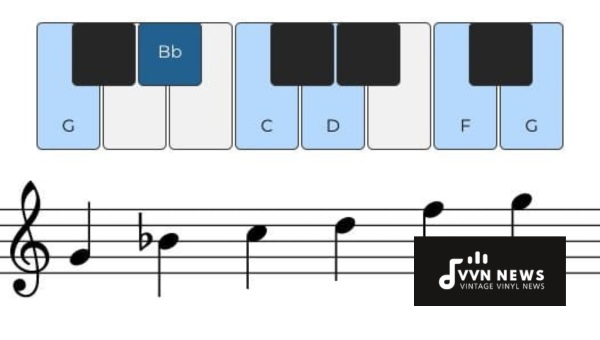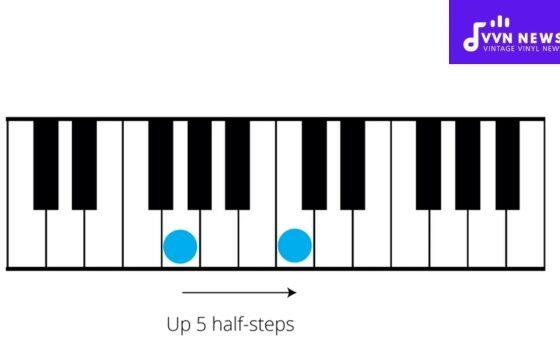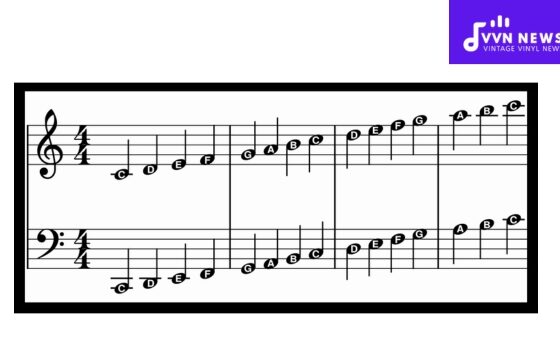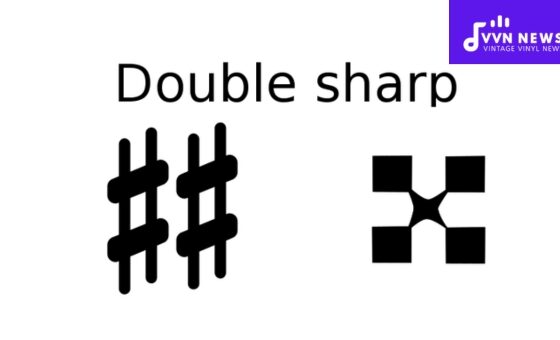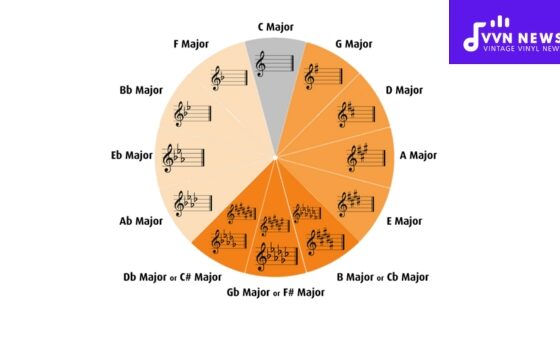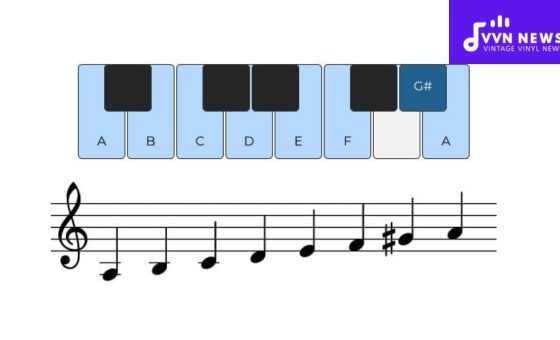If you’re an aspiring musician or a seasoned veteran looking to spice up your guitar licks, expanding your knowledge of scales can change the tune completely.
Today, I’m going to share everything you need to know about one such evocative scale – the G minor pentatonic scale.
Famed for its brooding, soulful sound, the G minor pentatonic scale opens doors to musical genres ranging from rock and blues to jazz and country.
With its wide tonal range and expressive quality, familiarizing yourself with this five-note gem can be an exciting adventure.
Walk with me on this melodious journey, it’s more than just hitting a set of random notes; it’s about feeling the rhythm, embracing the melody, and creating something beautiful from seemingly simple ingredients.
What is the G Minor Pentatonic Scale?
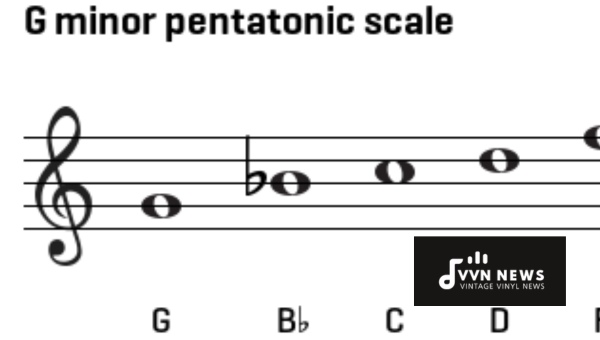
Enveloped by a depth of emotion and versatility, the G minor Pentatonic Scale comprises five distinctive notes – G, Bb, C, D, and F.
Stripping down to its basic roots, the ‘Penta’ in pentatonic refers to the number five, while ‘tonic’ pertains to its tones.
In essence, unlike a heptatonic scale that comprises seven notes, a pentatonic scale is composed of five distinguished tones.
Brimming with richness and adaptability, G Minor Pentatonic injects life into musical pieces across genres.
From weaving stories in Blues to setting pulses racing in Rock – it’s a powerhouse tool every musician should have up their sleeve!
The Creation Procedure of the G Minor Pentatonic Scale
To form a G minor pentatonic scale, you need a combination of five notes. These are the root (G), minor third (Bb), perfect fourth (C), perfect fifth (D), and minor seventh (F).
This selection excludes the second and sixth notes found in a traditional G minor scale.
Here are the sequential steps to craft this unique scale:
- Identify the Root Note: Start with your root note, which is ‘G’ in this case.
- Find the Minor Third: Followed by B-flat (Bb). Here, you’re lowering the B note of a regular G minor scale.
- Pinpoint the Perfect Fourth and Fifth: Next comes C and then D without any alterations.
- Direcr to Minor Seventh: Complete your scale with an F note, which is also unchanged from the standard G minor.
Whether you’re on your piano or your guitar, keep this sequence close at heart – G, Bb, C, D, and F – and you will have mastered one of music’s most expressive scales – the G Minor Pentatonic Scale.
How to play the G Minor Pentatonic Scale in different positions?
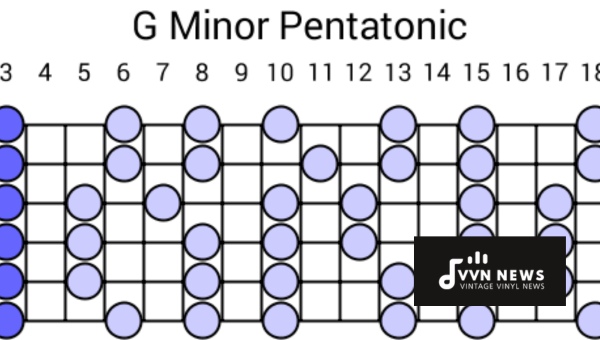
Let’s delve deep into the techniques of playing the G minor pentatonic scale in different positions on the guitar fretboard.
Please keep your fingers ready, as we’ll be exploring five unique shapes.
The Root Position
Positioning your hand at the third fret, this is where G minor pentatonic has its root note – on the low E string.
This starting position forms what musicians call “the box pattern.” You’ll go from the 3rd to 6th fret on the first two strings (E and A), shift one step up to cover 3rd to 5th fret on strings marked D and G, and another shift up hit the remaining two strings (B and E) from third to sixth.
The one-octave Up
This shape begins one octave up from shape 1. Starting at the B string’s third position (G note), run horizontally over three strings (B-G-D), gradually climbing down from the sixth to the third fret.
Horizontal Scale Pattern
Are you looking for an easy pathway across the neck of your instrument? Consider this lateral pattern.
For this, you’ll have your hand stretched across four different positions spanning six strings – a marathon of notes ranging from roots, diminished fifths, perfect fourths, and sevenths.
Diagonal Scale Pattern
Offering richer tone variation, diagonal patterns ride multiple octaves with ease.
Start from the G-string’s fifth position, moving towards the B-string, which is also in the fifth position, and then finally touch down onto the high E-string, landing at the eighth position.
Three-Notes-Per-String Pattern
A playground for speedsters! Here, in each beat, three notes are played per string, which sets the arena for sweeping arpeggios and speedy scale runs.
Once you’ve mastered each of these shapes individually, try transitioning from one shape to another seamlessly.
This will allow you to feel the rhythm and soul of the G minor pentatonic scale, giving your solos depth and nuance.
Also Read: G Flat Minor Triad [Mastering Complex Guitar Chords]
What are the major and major scales in the G Minor Pentatonic Scale?
Before diving into the nitty-gritty, let’s make sure we have our fundamentals covered.
A pentatonic scale is a five-note scale typically used across many different musical genres.
The G minor pentatonic scale, as you might guess, is rooted in the key of G minor.
Major Scales
The term major in the context of scales usually refers to a seven-note (heptatonic) scale known as the major scale.
The most common major scale is C Major, comprised of the notes C-D-E-F-G-A-B.
A major scale offers a cheerful or ‘happy’ sound. This contradicts the G minor pentatonic’s gloomy mood.
On transposing it to the G major pentatonic scale, it consists of five unique notes: G, A, B, D, and E.
Minor Scales
In opposition to this, we have minor scales that generally provide a more somber or ‘sad’ sound.
A general minor (natural) consists of seven distinct notes that vary from its sibling major scales by placement of half steps.
Getting down to our main protagonist – the G minor pentatonic – it includes five different notes: G, B flat, C, D, and F.
Please take note that these aren’t variations of major scales but rather their unique setup contributing to their characteristic resonating sounds.
While there’s no straight ‘major’ equivalent within a minor pentatonic context per se, your understanding of how these scales function can help you better navigate around this mysterious yet captivating world of music theory.
Tips on Utilizing Backing Tracks to Grasp the G Minor Pentatonic Scale
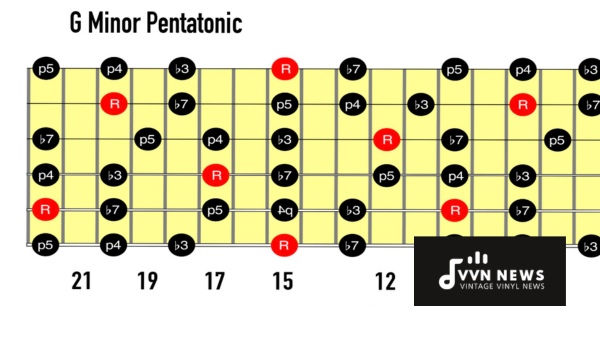
If you’re interested in learning the G Minor Pentatonic Scale, utilizing backing tracks can be incredibly beneficial.
It not only aids in practicing the scale but also fosters an inner sense of groove and timing. Here are some guidelines to get started.
Identify Suitable Backing Tracks
Firstly, you should allocate proper backing tracks that match your level of proficiency.
Plenty of websites and YouTube channels offer free backing tracks for an extensive array of scales including G minor pentatonic.
Start Slow and Gradual
Secondly, don’t rush. Begin with a slow tempo and slowly work your way up as your fingers get familiar with the scale patterns on the fretboard.
This approach helps in establishing firm hand-eye coordination and preventing mistakes before they become bad habits.
Applying Scale Patterns
Next up is the implementation phase, where you’ll need to apply the scale patterns you’ve learned over these backing tracks.
A key point to remember here is to start simple. Limit yourself to one or two patterns initially and expand as you progress.
Improvise!
The beauty of playing along with a G minor pentatonic backing track lies in the scope it provides for improvisation.
Try creating different licks or melodies using this scale over the track, as it gives room for exploration while providing invaluable ear training sessions.
And here’s a trick – it’s often easier to get started with improvisation by restricting yourself to just a few notes from the scale rather than attempting all five at once.
And with that, you are now ready to practice the G minor pentatonic scale using backing tracks!
It may seem daunting in the beginning, but a regular practice routine combined with insightful listening can do wonders.
Also Read: F Minor Blues Scale [Experiment With This Dark & Moody Key]
Ear Training and the G Minor Pentatonic Scale
Training your ear is an essential aspect of mastering any musical instrument, including using scales like the G minor pentatonic.
It’s a necessary component for any aspiring musician, helping you to discern pitches, intervals, melody, rhythms, and other basic elements of music.
Here are five ways that ear training can assist in playing the G minor pentatonic scale:
Helps with Pitch Recognition
Do you wonder how some musicians can play a tune after hearing it just once? That’s because they have well-trained ears that can swiftly perceive pitch.
In essence, pitch recognition is the ability to identify the pitch of a note or to produce any given pitch.
A well-trained ear will help you recognize the distinct tones in the G minor pentatonic scale and replicate them on your instrument.
Aids in Interval Identification
Musical speech is all about intervals – distances between two pitches. If you work on interval recognition as part of your ear training regime, it will make navigating the G minor pentatonic scale much easier.
You’ll be able to identify swiftly how far apart notes are from each other.
Enhances Melody Playback
Once you’ve got a handle on pitch recognition and interval identification, reproducing melodies becomes child’s play (pun intended!).
Tuning one’s ears is especially crucial when exploring scales such as the G minor pentatonic scale, known for its haunting melodies.
Harmonization Simplification
Being able to hear harmonies intuitively has a significant impact when structuring chords within a scale or improvising solos on top of chord progressions.
Acute listening skills can guide you in creating harmonically rich compositions using the G minor pentatonic as your foundational tool.
Boosts Improvisational Skills
Lastly but most crucially, continuous ear training cultivates superb improvisational skills.
This sacred skill makes it seamlessly comfortable for a musician to invent new melodies in the groove.
The G minor pentatonic scale is a favorite amongst many musicians, especially for blues improvisation.
Training your ear will make you more attuned to the tonal texture and can take your improvised solos to unprecedented heights.
Ear training is an absolute game-changer in mastering the G minor pentatonic scale or any scale for that matter.
It empowers you to replace reliance on sheet music with intuitive, automatic playing that truly speaks from the soul.
Popular songs that feature the G Minor Pentatonic Scale

Whether you’re striving to recreate a beloved piece or find inspiration for your next creation, looking at popular tunes featuring the G minor pentatonic scale is the perfect place to start.
This dynamic scale has been used by numerous artists across genres, breathing life and depth into their pieces. Let’s dive into a few songs that have majestically used this scale.
1. “Sunshine Of Your Love” by Cream
This iconic track, spearheaded by the legendary guitarist Eric Clapton, is a perfect illustration of the G minor pentatonic scale in action.
With an instantly recognizable riff, the melody meanders through the notes with a feeling of barely restrained energy.
2. “Money” by Pink Floyd
David Gilmour’s hypnotic guitar solo in Pink Floyd’s “Money” beautifully showcases how simple patterns based on the G minor pentatonic scale can create a deeply mesmerizing sound. The song practically invites you to pick up your guitar and play along.
3. “Stairway to Heaven” by Led Zeppelin
Even if it is not entirely based on the G minor pentatonic scale, Jimmy Page’s iconic solo on “Stairway to Heaven” does employ elements from it.
The tune is powerful and evocative and demonstrates just how versatile this scale truly is!
4. “Purple Haze” by Jimi Hendrix
A list of G minor pentatonic scale-based songs wouldn’t be complete without mentioning Jimi Hendrix’s revolutionary playing on “Purple Haze“.
It wonderfully captures his genius in using this moody and expressive scale with creativity and flair!
5. “Black Magic Woman” by Santana
Carlos Santana’s rendition of “Black Magic Woman” draws heavily from the G minor pentatonic scale.
Many fans and critics regard this tune as a crowning achievement in expressing emotion through simple melodic lines.
These tunes underscore the hidden depths of the G minor pentatonic scale, providing a testament to its powerful expressiveness and distinct versatility.
Also Read: D Major Chords [Unlock The Power Of Your Guitar]
FAQs About The G minor pentatonic scale
Why is the G Minor Pentatonic scale called pentatonic?
It’s called pentatonic because it comprises five distinct notes within one octave, from ‘Penta,’ which means five in Greek.
Can I use the G Minor Pentatonic scale on other instruments?
Absolutely! Although often associated with the guitar, the G Minor Pentatonic scale can be applied to any melodic instrument— from piano to violin and even wind instruments.
How does learning the G minor pentatonic scale benefit a beginner musician?
For beginners, learning this scale assists in understanding fundamental music concepts. Also, it can broaden your musical repertoire and enable you to improvise better.
If I’m familiar with the major pentatonic, will it be easier for me to learn the minor pentatonic scales?
Yes, if you already know a major pentatonic scale, you can easily derive its minor counterpart and vice versa. This interchangeability can potentially save much learning time.
What’s the difference between a Major Pentatonic Scale and a Minor Pentatonic Scale?
The key difference lies in their tonal quality. Major pentatonic scales generally create a happy mood, while minor pentatonic have a bluesier edge and often evoke emotional or sad feelings.
Conclusion
The G minor pentatonic scale is a wonderful tool to have in your musical toolbox.
Whether you’re a beginner searching for an approachable platform to start improvising or a seasoned musician desiring to add some soulful depth to your riffs, this five-note formula could be just what you’re seeking.
This journey into music may be challenging, but with consistent practice and passion, your ears will start recognizing patterns and your fingers will start moving with ease.
